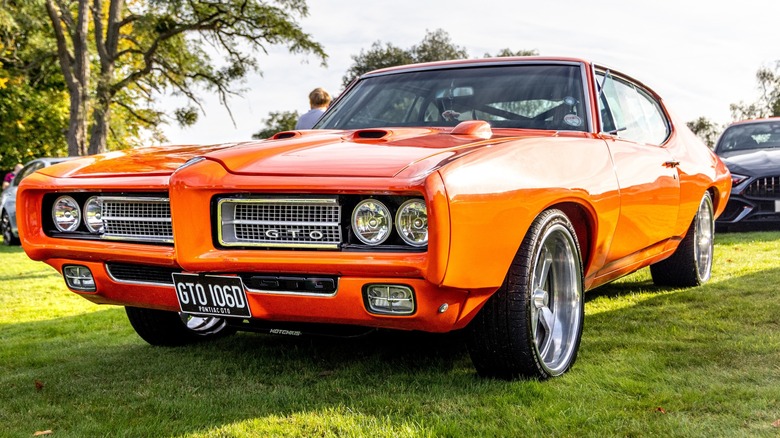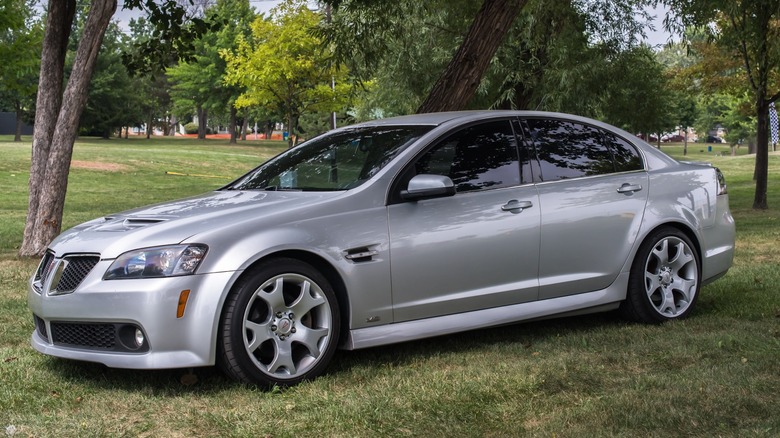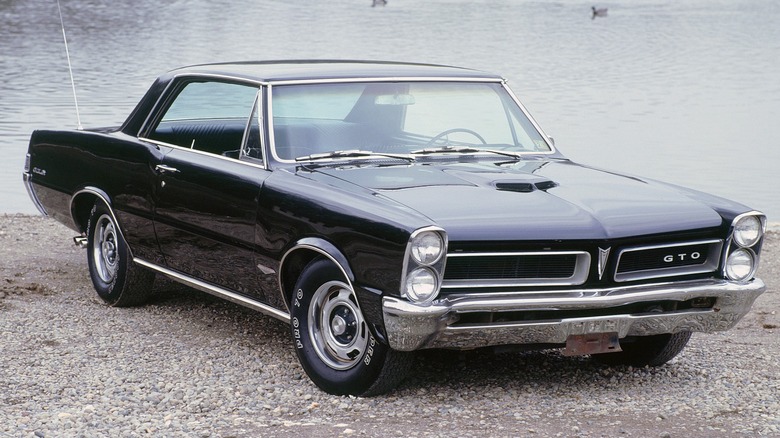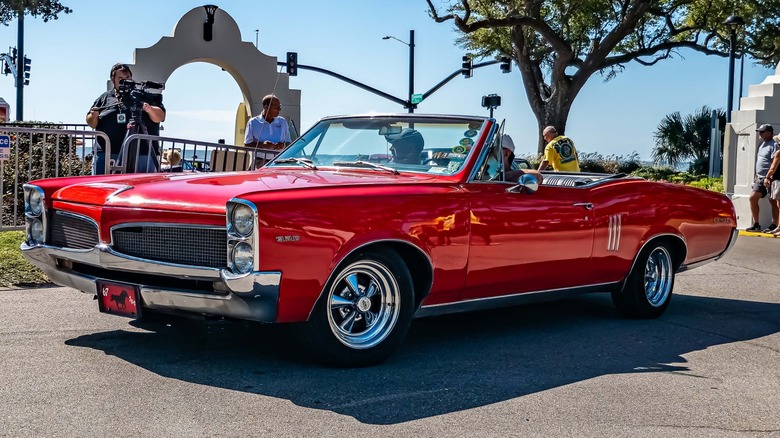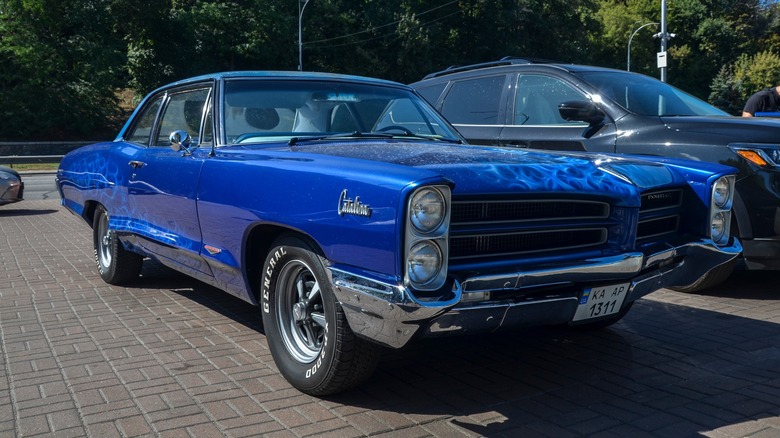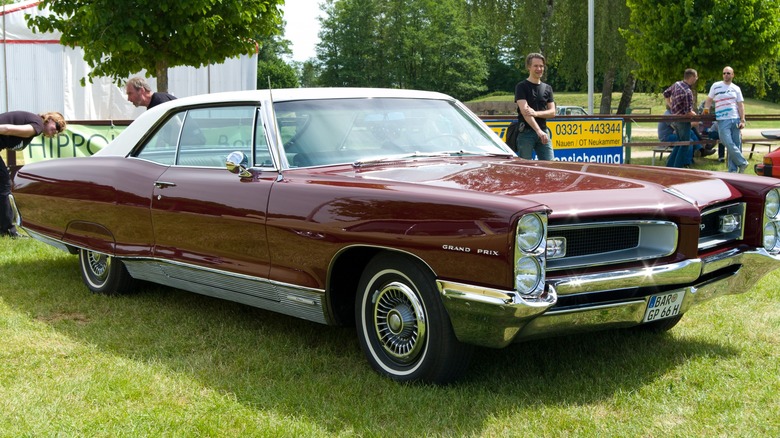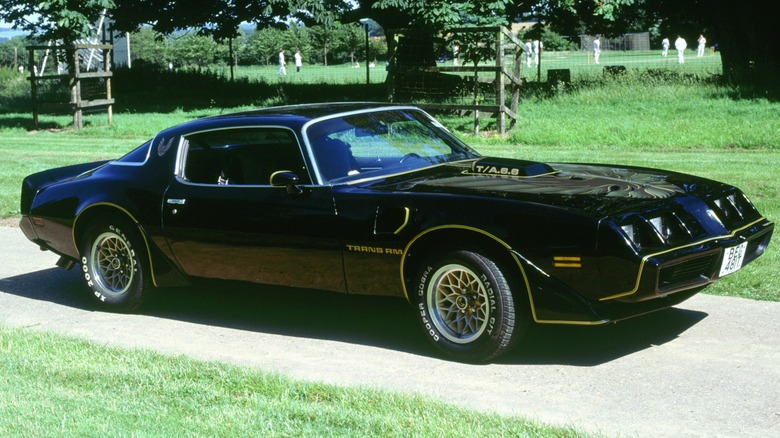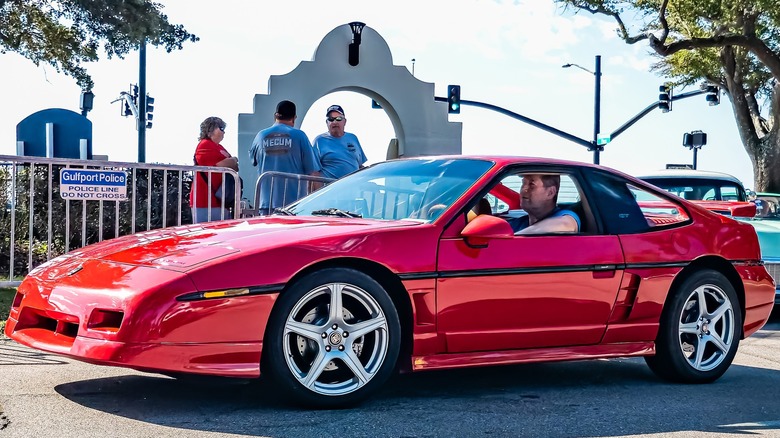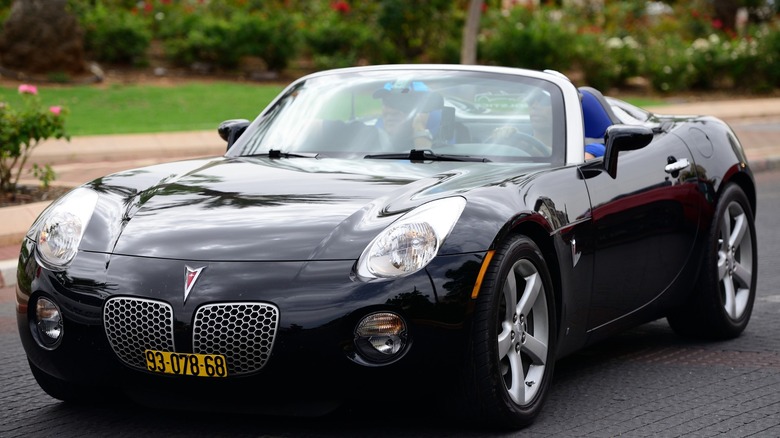8 Classic Pontiac Models With Great Resale Value
While many were sad seeing the last Pontiac ever to leave the factory in 2010, management at General Motors was convinced at the time that it had to be done to keep the company from going under. One could argue they should have kept Pontiac and axed Buick, but that is all water under the bridge by now. One thing is certain — potential future classic Pontiacs stopped being made nearly 15 years ago. This means pretty much all Pontiacs ever made are now classics. That said, some models we'll cherish for years to come, while others are best forgotten. Regardless, there are still millions of old Pontiacs roaming the streets and tucked away in garages from coast to coast in various states.
The resale value of new cars typically drops immediately after buying, with some brands, like BMW and Mercedes, experiencing sharper depreciation than others. Values of used cars can be less predictable, especially those of a defunct brand. And when a brand has been out of production for 15 years, the values of its models can either fall to practically nothing or rapidly rise like a meme stock or cryptocurrency. However, even classic cars tend to be at least marginally more predictable than those. Nonetheless, Pontiac created a whole host of desirable models in its many decades of car production, and while this is not to be construed as investment advice in any way, these classic Pontiacs can expect excellent resale values.
Pontiac G8
For just two short years, Pontiac offered what is likely one of the best American sports sedans ever made. However, that's a bit misleading, as the Pontiac G8 was actually built in Australia and originally named Holden Commodore. Regardless of who built it, the G8 offered buyers bold styling, an upscale interior, and, in the GXP model, a potent 415 hp LS V8 engine.
When the G8 was new, it stood out in GM's lineup, which was shifting to front-wheel drive across all divisions, even offering a V8-powered Impala SS with front-wheel drive. But for the best handling and cornering, rear-wheel drive is preferable, and the G8 delivered an excellent driving experience, competing well with German cars while treating occupants to a similarly refined interior.
As a relatively new model in classic car circles, the G8 maintains a fervent fanbase. The allure of driving a powerful car with modern amenities and stylish design is undeniable. Values for the G8 have been steadily increasing over the last decade, making it one of the most collectible Pontiac cars worth buying. Recent auctions for G8 cars have seen winning bids as low as $12,500 while GXP models can reach near $50,000. But as a newer car, there is still plenty of time for things to change and room for values to go up.
Pontiac GTO
Under the leadership of John DeLorean, Pontiac's division at GM created an option package for its intermediate LeMans model in 1964, which many claim to be the first genuine "muscle car." Regardless, the package quickly gained popularity and became a stand-alone model within a couple of years. As the decade progressed, improvements in engines, options, and accessories turned the GTO into one of the most sought-after cars of the era. However, while Pontiac sold nearly 100,000 units in 1966, sales dwindled to just 10,532 by 1971 as the GTO's heyday waned. A revised model came in 1973, followed by another GTO based on the Ventura in 1974, although both of these cars lost the power and impact of their predecessors.
Today, nearly any GTO model is likely to retain its value. A convertible GTO Judge model sold for $1.1 million in 2023, representing the peak of the market, while the less powerful 200 hp 1974 model can go for as little as $9,500. Values have increased over the last decade but leveled off since the 2023 peak. Pontiac's 2004 revival of the GTO — a rebadged Australian-built Holden Monaro built until 2006 — has potential for appreciation, with Hagerty showing a steady upward trend likely to continue as these cars go beyond 20 years of age. No matter which GTO you might want, it's likely to be a worthwhile investment.
Pontiac LeMans
Pontiac introduced the LeMans trim as an option for its compact Tempest beginning in 1961. Its popularity led to it becoming a stand-alone model, with the first LeMans featuring new sheet metal in 1964. Named after the storied European 24-hour endurance race, the LeMans had a lot to live up to.
While the LeMans is well known for being the basis of the iconic GTO, it is also a highly collectible car in its own right. Pontiac kept the two-door LeMans in production through 1981, making a few changes in body styles, and revived the name again in 1988 to ostensibly ruin the LeMans name by attaching it to a poorly received Korean hatchback econobox with neither style nor power.
The early Pontiac LeMans models remain the most desirable in the classic car market. A rare GT-37 allowed buyers to order the same engine as a GTO. This provided an opportunity for collectors, as its value, according to Hagerty, has been steadily increasing without the recent price dips seen in similar cars. Models from 1973 through 1981 are still very affordable at less than $10,000, though the downsized models after '78 are unlikely to become coveted classics. As for any remaining imported Daewoo-built Korean LeMans, the most humane option might be to send them straight to the crusher.
Pontiac Catalina
Starting in 1950, Pontiac designated its pillarless two-door hardtop style as the Catalina. Named after the resort island off the coast of Southern California, the Catalina name caught on well enough to become a new model in 1959. The new Pontiac Catalina was a full-size car placed just below the slightly larger Bonneville in the hierarchy. While the two models were similar in some aspects, there were notable differences that set them apart. The Catalina remained part of the Pontiac lineup until 1980, ending a 31-year run.
While full-size cars of the '60s aren't generally as prized as some muscle cars, the '62 Pontiac Catalina that ran on NASCAR tech is a rare exception. Loaded with the then-new 421 Super Duty V8, built with racing components such as forged rods, four-bolt mains, and high-flow heads, drivers had more than 400 hp at their beck and call to push these big Catalinas to their limits. This was followed by the Catalina 2+2 option with a Tri-power 421 in 1964 through 1967. In 1971, the Catalina grew into a lumbering and dull family sedan with underpowered V8s before being downsized in '77, only to be phased out altogether in '81.
The '62 Super Duty is by far the most valuable Catalina ever made, with winning bids surpassing $500,000. But the market is still strong for others. Sales for clean Catalinas through 1967 can reach up to $100,000, though prices drop sharply for later models.
Pontiac Grand Prix
Using the Catalina platform as its foundation, Pontiac created the Grand Prix personal luxury coupe for the 1962 model year to compete directly with the Ford Thunderbird. While it was meant to compete in the personal luxury segment, performance was a core part of the car's identity, as suggested by its name, borrowed from a historic automobile race.
First-generation models came with engine options ranging from 300 to 400 hp, making the Grand Prix a potent street racer, particularly when equipped with the 421 Super Duty. But as the GTO took over the performance mantle, the Grand Prix grew in size to better suit the luxury segment, a place where it would remain for years. The large luxury look dominated Grand Prix models through the '70s until downsizing came in 1981. Front-wheel-drive arrived in 1988, and this applied to all remaining Grand Prix models until the model was discontinued in 2008.
There are several Grand Prix models that can sell for large sums, with early Super Duty models reaching over $200,000. Special editions, such as those from Hurst or later Petty's Garage cars, remain highly collectible, although cars from the '80s tend to be at the lower end of the market. The last-generation GTP and GXP models have strong potential for growth, especially clean, low-mileage examples that may appreciate in value.
Pontiac Firebird
As Pontiac's long-time sports car, the Firebird was bound to be popular. It shot out of the gate after its 1967 introduction and stayed a favorite through nearly four decades of production. The classic 1967 pony car evolved through the years to eventually become a modern performance machine while keeping true to its muscle car roots.
While it arrived toward the end of the muscle car era, the Firebird and its higher-spec Trans Am variant managed a few good years with impressive performance. Pontiac held out longer than others by offering the big-block Super Duty 455 V8 through 1974 — a less powerful 455 was available in '75 and '76, but it fell far short of the Super Duty. A lighter, sleeker, and better-handling Firebird arrived in 1982, ushering in a new era of automaking that relied more on technological know-how than brute force for power. By the arrival of the fourth generation, big power numbers had returned, with the LS V8 setting new records, making the Firebird one of the fastest Pontiac cars of its time.
Owning nearly any year Firebird is a good investment, particularly the early models. However, looking through sold listings of all-year models, there are still plenty of Firebirds selling for under $5,000, including special editions like the Firehawk. While the top end of the market is dominated by cars from the first 10 years of production, well-preserved examples of later models are also likely to appreciate in value.
Pontiac Fiero
When Chevrolet debuted the C8 Corvette with its mid-engine layout, it wasn't GM's first mid-engine car. The idea actually originated in 1978, when Pontiac managers set out to build a two-seater commuter car with a 4-cylinder engine to help meet corporate fuel economy standards. It was not meant to be a new high-performance car, and the budget was set extraordinarily low. Despite the constraints, the new mid-engine Fiero arrived for the 1984 model year.
Powered by the "Iron Duke" 2.5-liter 4-cylinder engine and equipped with suspension parts borrowed from the Chevette and other small cars, the Fiero failed to impress with its 92 hp and heavy steering, but it looked good. So, despite its poor driving experience, its styling helped drive strong sales. It continued to sell and later gained more powerful GT versions with fuel-injected V6 engines and additional styling elements for the body.
Pontiac canceled the Fiero after the 1988 model year, but the real reason the Pontiac Fiero was discontinued goes beyond its design limitations. Despite managing to sell enough units to keep it somewhat plentiful today, there were persistent issues with reliability and performance that ultimately sealed its fate. Fieros from all years tend to hold their value, with base 1984 models selling for a modest $4,000, while the nicest examples of 1988 GT models go for more than $20,000. Furthermore, Hagerty shows the 1988 GT value rising steadily over the last five years, making them something worth checking out.
Pontiac Solstice
Pontiac's return to the Fiero concept came just as the brand was disappearing. Like the Fiero, the Pontiac Solstice was a lightweight two-seater, but it differed by being driven from the front like a traditional roadster. The design choice made it easier and cheaper to implement while holding broad appeal for consumers. The final product turned out to be highly attractive, extremely fun to drive, and an exceptional example of what happens when a carmaker gets everything right.
Offered from 2007 until 2009, the Solstice came with a choice of 2.4-liter engine with 177 hp or a turbocharged 2.0-liter with 260 hp in the GXP model. The latter could reach 60 mph in just 5.5 seconds, and when combined with its ultra-tight cornering and braking, it made for a thrilling driving experience. To further enhance things, the car is genuinely attractive and comes with a clean and driver-focused interior, one of the better examples of the era.
Recent sales of the Solstice are a bit varied. Hardtop coupe GXP models with very low mileage can approach the $40,000 mark, while convertible GXP models regularly sell for around half of that. If you want a nice driver with a bit more mileage, there are still deals around below $10,000, but Hagerty does show a steady rise over the last five years, so the Solstice is another one to watch.
